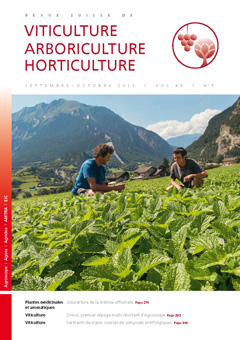
Issue 5 - September - October 2013
Abstract in open access
In mountainous areas of Switzerland, some producers cover their lemon balm fields with a non-woven agrotextile veil to protect them from the cold and extend the growing season. The effects of this practice on the yield and quality were closely studied, in particular on essential oil (EO) and rosmarinic acid (RA) contents. The warmer climate created under the agrotextile veil doubled the production of EO. A good correlation was observed between the average temperature during 28 days preceding the harvest and the EO production, with the highest level of EO recorded in summer harvest, whereas the content of RA was reduced by the veil. RA content was by 11–15 % lower than that of uncovered variants. By shading effect, the veil contributes to elongate the internodes, which penalizes leaf production and amplifies RA yield reduction. Lower temperatures were found to have a positive effect on the content of RA, including the last few days before harvesting. The September harvest was richer in RA. These results, and also the fact that temperature under cover has less effect on vigorous crops, allow to recommend the uncovering of the crops one week before harvesting in order to optimize RA and EO production as well as to improve the leave rate.
Keywords: lemon balm, rosmarinic acid, essential oil, agrotextile, Lamiaceae, Melissa officinalis
E-Mail: claude-alain.carron@agroscope.admin.ch
Adress: Agroscope, 1964 Conthey
Abstract in open access
In Switzerland, the most cultivated variety of peppermint is Mentha ïƒ—ï€ piperita ‘541’, a clone native from Crimea. For some time, producers have observed a significant drop in production, which could be the result of clonal degeneration. The clone ‘541’ grown in Switzerland has been compared to the original Crimean ‘541’ as well as to 33 other mint varieties by the analysis of 20 RAPD (Randomly Amplified Polymorphic DNA) markers. The genetic distance between both clones ‘541’ was 0 %, showing their perfect genetic identity. The explanation of the differences therefore most likely lies in cultural or epigenetic causes. In addition, in the case of orange mint (Mentha xï€ piperita var. citrata), a genetic distance of 7 % was observed between the accession cultivated in Switzerland and the one maintained in vitro, which could mean the existence of two distinct clones.
Keywords: mint, genetic distance, clones, DNA markers, Lamiaceae
E-Mail: jose.vouillamoz@agroscope.admin.ch
Adress: Agroscope, 1964 Conthey
Abstract in open access
A first variety of grape resistant to downy mildew (Plasmopara viticola), powdery mildew (Uncinula necator) and grey mould (Botrytis cinerea) selected by Agroscope has just been approved and released on the market. This red variety resulting from a 1997 crossbreeding between Gamaret and Bronner, was baptized Divico in homage to a mythic Helvetian leader. Its resistance to fungal diseases is high but not absolute. Only one to three chemical treatments during the flowering-to-berry set period are needed for an efficient protection. Divico should be cane-pruned in order to favour fertility. Despite a precoce vegetative cycle, it should be harvested late to insure proper grape maturity. Divico wines are appreciated in tastings: they are coloured, structured with round and soft tannins and are characterized by fruity and spicy bouquets.
Keywords: grapevine, Divico, disease resistance, Plasmopara viticola, Uncinula necator, wine quality
E-Mail: jean-laurent.spring@agroscope.admin.ch
Adress: Agroscope, 1009 Pully
Abstract in open access
Crude methanolic and ethanolic extracts of Vitis vinifera canes cv. Pinot noir, Gamaret and Divico, have shown high fungitoxic activities against downy mildew (Plasmopara viticola), powdery mildew (Erysiphe necator) and grey mould (Botrytis cinerea), while aqueous extracts did not show any effect. Extracts have been separated according to their polarity in four fractions by chromatography. The toxicity of each fraction has been analyzed, showing that each exhibits an high activity against downy mildew, three of them against grey mold, while the most apolar fraction is active against powdery mildew. Among all constitutive components of the methanolic extract, six major components have been first identified and their toxicity against P. viticola was calculated (IC50). E-Vitisine B and hopeaphenol are the two most fungitoxic stilbenes with very low IC50 values, respectively 13 and 17 μM. However, the components of the crude extract exhibit a high light sensitivity: an exposure of 24 h is sufficient to alter them. The opportunity to formulate a stable and innovative antifungal product to protect grapevine is discussed.
Keywords: downy mildew, powdery mildew, grey mould, canes, natural products
E-Mail: katia.gindro@agroscope.admin.ch
Adress: Agroscope, 1260 Changins/Nyon
Abstract in open access
Through rapid immunological tests, the presence of a grey mould infection in grapes can be detected in less than 10 minutes. For a few years, such kits have been commercialized in United-States and Europa. The pertinence of these tests has been studied by Agroscope, in particular on 11 different Swiss grape varieties such as Gamaret, Gamay, Chasselas or Petite Arvine. Our results confirm that the grey mould can be detected in berries as well as in must or wine, independently of the grape variety. However, only active infection is detected, not its latency. A positive correlation was established between the results of the kit tests and the presence of chemical markers for grey mould. The tested kit appears then reliable for characterizing the sanitary conditions of a vintage.
Keywords: Botrytis cinerea, lateral flow devices, grey mould, galacturonic acid, mucic acid
E-Mail: agnes.dienes-nagy@agroscope.admin.ch
Adress: Agroscope, 1260 Changins/Nyon

 Download of full issue
Download of full issue
 Download article
Download article